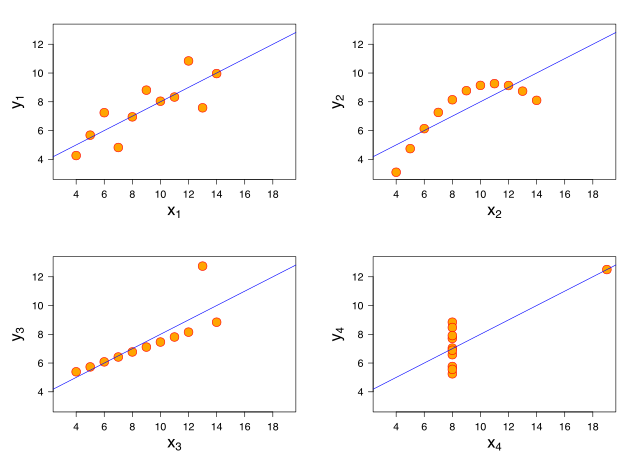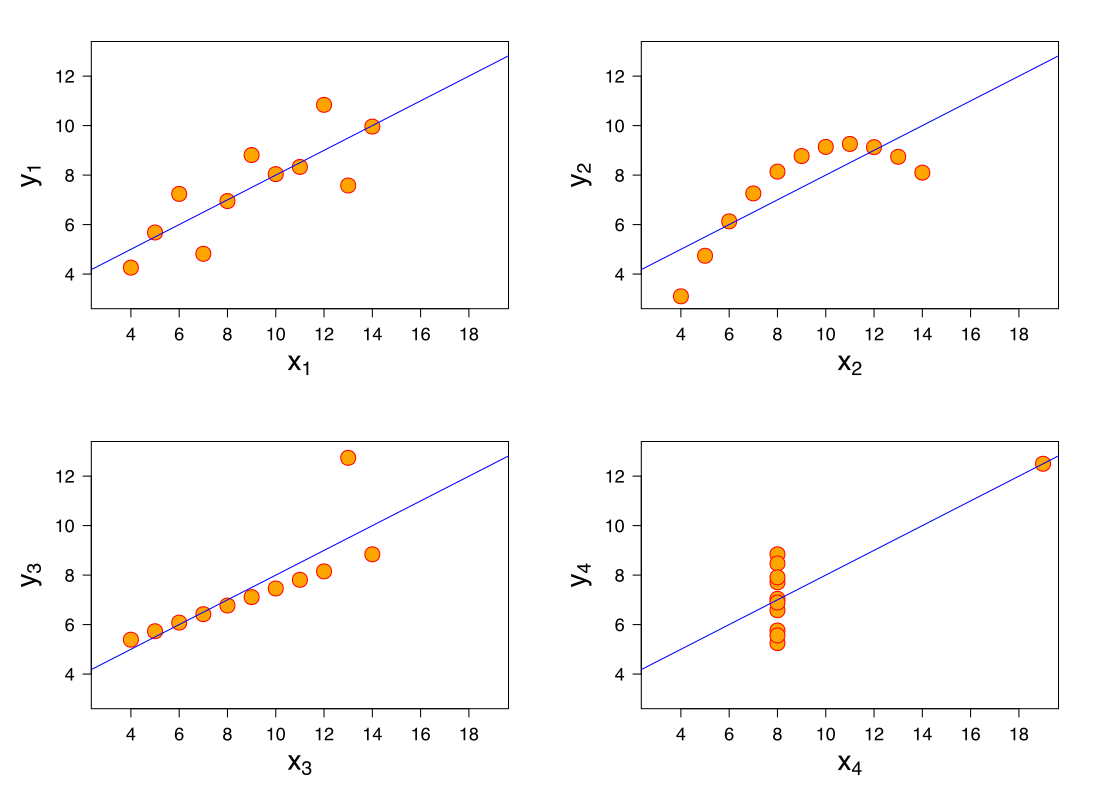Anscombe's quartet
Four data sets with the same descriptive statistics, yet very different distributions From Wikipedia, the free encyclopedia
Anscombe's quartet comprises four datasets that have nearly identical simple descriptive statistics, yet have very different distributions and appear very different when graphed. Each dataset consists of eleven (x, y) points. They were constructed in 1973 by the statistician Francis Anscombe to demonstrate both the importance of graphing data when analyzing it, and the effect of outliers and other influential observations on statistical properties. He described the article as being intended to counter the impression among statisticians that "numerical calculations are exact, but graphs are rough".[1]

Data
Summarize
Perspective
For all four datasets:
| Property | Value | Accuracy |
|---|---|---|
| Mean of x | 9 | exact |
| Sample variance of x: s2 x |
11 | exact |
| Mean of y | 7.50 | to 2 decimal places |
| Sample variance of y: s2 y |
4.125 | ±0.003 |
| Correlation between x and y | 0.816 | to 3 decimal places |
| Linear regression line | y = 3.00 + 0.500x | to 2 and 3 decimal places, respectively |
| Coefficient of determination of the linear regression: | 0.67 | to 2 decimal places |
- The first scatter plot (top left) appears to be a simple linear relationship, corresponding to two correlated variables, where y could be modelled as gaussian with mean linearly dependent on x.
- For the second graph (top right), while a relationship between the two variables is obvious, it is not linear, and the Pearson correlation coefficient is not relevant. A more general regression and the corresponding coefficient of determination would be more appropriate.
- In the third graph (bottom left), the modelled relationship is linear, but should have a different regression line (a robust regression would have been called for). The calculated regression is offset by the one outlier, which exerts enough influence to lower the correlation coefficient from 1 to 0.816.
- Finally, the fourth graph (bottom right) shows an example when one high-leverage point is enough to produce a high correlation coefficient, even though the other data points do not indicate any relationship between the variables.
The quartet is still often used to illustrate the importance of looking at a set of data graphically before starting to analyze according to a particular type of relationship, and the inadequacy of basic statistic properties for describing realistic datasets.[2][3][4][5][6]
The datasets are as follows. The x values are the same for the first three datasets.[1]
| Dataset I | Dataset II | Dataset III | Dataset IV | ||||
|---|---|---|---|---|---|---|---|
| x | y | x | y | x | y | x | y |
| 10.0 | 8.04 | 10.0 | 9.14 | 10.0 | 7.46 | 8.0 | 6.58 |
| 8.0 | 6.95 | 8.0 | 8.14 | 8.0 | 6.77 | 8.0 | 5.76 |
| 13.0 | 7.58 | 13.0 | 8.74 | 13.0 | 12.74 | 8.0 | 7.71 |
| 9.0 | 8.81 | 9.0 | 8.77 | 9.0 | 7.11 | 8.0 | 8.84 |
| 11.0 | 8.33 | 11.0 | 9.26 | 11.0 | 7.81 | 8.0 | 8.47 |
| 14.0 | 9.96 | 14.0 | 8.10 | 14.0 | 8.84 | 8.0 | 7.04 |
| 6.0 | 7.24 | 6.0 | 6.13 | 6.0 | 6.08 | 8.0 | 5.25 |
| 4.0 | 4.26 | 4.0 | 3.10 | 4.0 | 5.39 | 19.0 | 12.50 |
| 12.0 | 10.84 | 12.0 | 9.13 | 12.0 | 8.15 | 8.0 | 5.56 |
| 7.0 | 4.82 | 7.0 | 7.26 | 7.0 | 6.42 | 8.0 | 7.91 |
| 5.0 | 5.68 | 5.0 | 4.74 | 5.0 | 5.73 | 8.0 | 6.89 |
It is not known how Anscombe created his datasets.[7] Since its publication, several methods to generate similar datasets with identical statistics and dissimilar graphics have been developed.[7][8] One of these, the Datasaurus dozen, consists of points tracing out the outline of a dinosaur, plus twelve other datasets that have the same summary statistics.[9][10][11]
See also
References
External links
Wikiwand - on
Seamless Wikipedia browsing. On steroids.

 ...
...